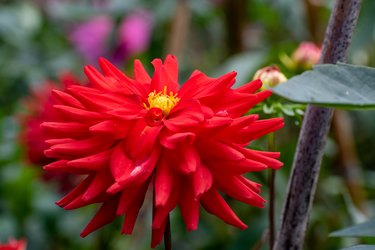
Native to Mexico's mountain plateaus, dahlias (Dahlia pinnata) thrive in locations with warm days and cool nights. Central Texas has warm days in abundance, but the nights are also warm. This can make planting dahlias in Texas a challenge, but not an impossible one.
Planting Dahlias in Texas
Video of the Day
Central Texas covers U.S. Department of Agriculture plant hardiness zones 7b through 8b. Dahlias are hardy in-ground in USDA zones 8 through 11, and they will also overwinter in zone 7b if the soil is well-drained and they're mulched. In cooler areas, gardeners lift dahlia tubers every winter and store them until the next spring.
Video of the Day
Though dahlias need warm winters to stay healthy in the ground, they also grow best in areas where summers don't get too hot. This makes planting dahlias in Texas problematic, especially in central Texas climates. Summers in central Texas are very hot, and in the northern part they are also muggy. You'll have to choose varieties that are listed as heat tolerant cultivars:
- 'Deuil du Roi Albert' -- The blooms are purple with white tips, and measure 4 to 6 inches. Plants grow 4 to 5 feet tall.
- 'Jersey's Beauty' -- Pink flowers measure 4 to 5 inches. One of the tallest dahlias, it reaches 6 to 7 feet high.
- 'Juanita' -- The cactus-style flowers are deep purple-burgundy. Blooms measure 6 inches, and the plant grows 4 to 5 feet tall.
- 'Kidd's Climax' -- This easy-to-grow dahlia has 8- to 10-inch blooms that blend pink, cream and lavender. Grows 3 to 4 feet tall.
- 'Prince Noir' -- An early bloomer with deep burgundy flowers that measure 4 to 5 inches. Grows 4 to 5 feet tall.
Growing Conditions for Dahlias
Choose a location with well-drained soil and at least 6 hours of sunlight each day. Because summers in central Texas are so warm, a location with some afternoon shade is best. This helps keep the plants from wilting, and preserves the best flower color.
Before planting dahlias in Texas, spread 1 to 3 inches of composted organic matter over the soil, and till to a depth of 8 to 10 inches. At the same time, work in a slow-release granular fertilizer with an N-P-K ratio of 8-8-8 or 10-10-10 at a rate of 2 to 4 tablespoons per square foot.
After all danger of frost has passed, plant dahlias so the tops of the tubers are covered by 2 to 4 inches of soil. Space plants 1 to 3 feet apart, depending on the mature size. Use round tomato cages to support tall dahlias, or place a wooden stake next to the plants that you can tie them to when they get taller. To encourage bushy plants, pinch the top set of leaves off with your fingernails once the plants have four sets of leaves on each stem. Provide support and pinching for the dahlias each year.
Ongoing Care for Dahlias
Annual rainfall varies from 22 to 52 inches per year in central Texas, and it's often less than 35 inches. Dahlias need soil that stays moist, but not waterlogged. They should receive water at least twice a week, either from rain or irrigation. On particularly hot days, mist dahlia leaves to help the plants cool down. Apply a 3- to 4-inch layer of mulch in the late spring to help keep the soil moist and cool during the summer. Mulching also protects plant roots in the winter.
Dahlias are heavy feeders, so fertilize regularly during the growing season. For central Texas, the growing season typically lasts from mid-March through November. Start fertilizing when the plants begin growing in mid-March or April, and continue through October or November. Choose a plant food formulated for flowering plants. These contain lower levels of nitrogen, so plants spend their energy on making flowers rather than on leaf growth.
For a slow-release bloom food with an N-P-K ratio of 9-18-9, apply at a rate of 1 tablespoon per square foot every three months. For a water-soluble bloom food with an N-P-K ratio of 10-30-20, apply at a rate of 1 teaspoon per 1 gallon of water every seven to 14 days.